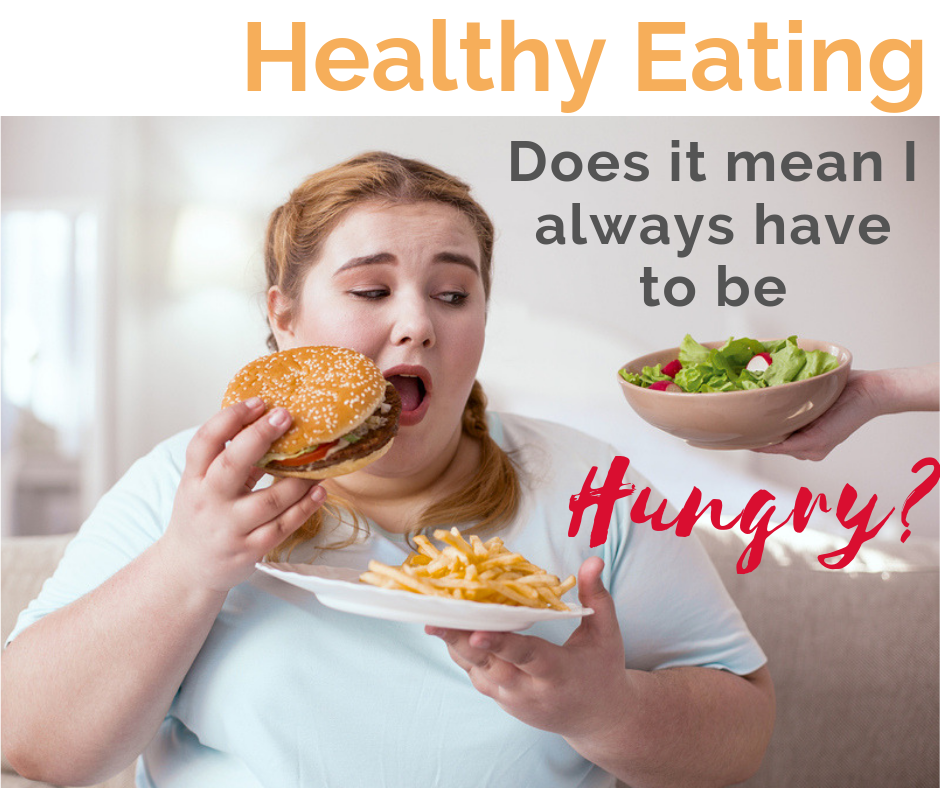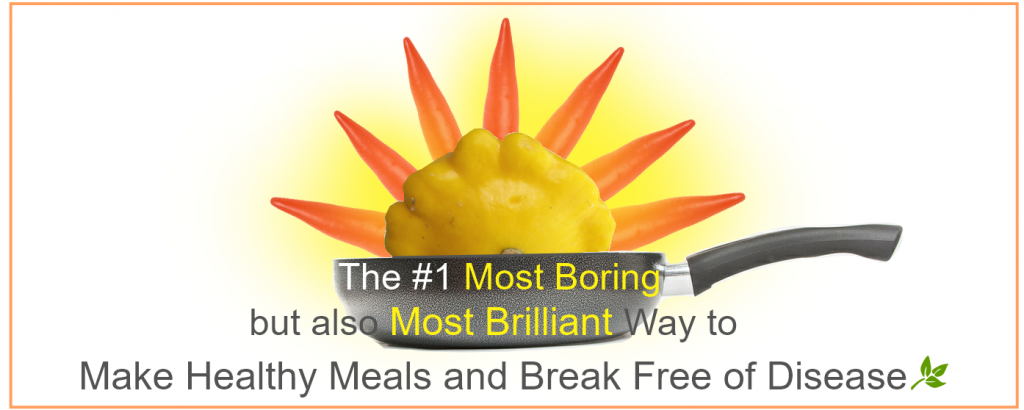
Isn’t it crazy that food can cause actual fear? Yet for many of us, the thought of “health-ifying” our diet does indeed cause at least an undercurrent of consternation, anxiousness, maybe despair.
But what if it isn’t just about the food . . .
and what if there’s an easier solution than sacrifice?
Obviously we know that committing to healthy eating doesn’t mean brown rice is suddenly going to gush in and flood your house, or that marauding bands of zucchini are going to rob you at gunpoint, or that you’ll be force-fed tofu till you pop!
Nevertheless, the prospect of dietary improvements can still spark some discomfort: “How am I going to live without ____________________?” (insert your particular fear foods.)
It’s easy to get sucked down on this scary path, but before going too far let’s explore some options:
What if your uncomfortable fears aren’t just about threats to your food favs,
but as importantly about your approach to mealtimes?
And what if the healthy eating transition could be a lot easier
if you focus on transforming your approach to mealtimes
rather than stressing and struggling to avoid foods you crave?
You probably know that “You’re Not Stuck with the Taste Buds You Have.” Your taste buds can actually adapt so you can live happily and well without your fear foods. But you must give them time to adapt to healthier foods before you fall into the deprivation trap and bail on the entire endeavor.
How do you do this? By making good, tasty, yummy, inviting meals!
Wow, does that sound a little simplistic–maybe even simple-minded? I think you’ll see what I mean with a couple examples, but first let’s explore what a good meal looks like.
Healthy Eating Is Easier Than You Think
With no less than 37 (or is it 97?!!) diets on the market today, it’s understandable if you’re confused about what a good meal looks like. In reality, as every traditional culture teaches us, it isn’t so very hard. Just eat real whole foods, in a wild and crazy diversity, with vegetables filling half your plate.**
Translating this Simple Prescription for Good Eating into a tasty meal on the table can be as simple as this:
- Start with a Large Portion of Vegetables, e.g., sautéed zucchini or steamed green beans
- Add a Starch or Another Veggie, like brown rice, sweet potato or sliced tomatoes and cucumbers
- Include a Protein, e.g., red or pinto beans, hamburger, chicken or pork chops
- Top with a Fun Sauce (optional, depending on your time) like the Mexican Sauce in the previous post, or a ready-made salsa
You can see that a perfectly healthy meal is not at all complicated–you can even buy many items pre-cooked or pre-cut (like plain deli chicken breasts, canned beans, microwaveable brown rice bowls, and pre-prepped or frozen green beans.)
Given these facts: Could you make a meal like this? Could you enjoy a meal like this? Could you feel pretty good about taking good care of yourself?
Of course you could do this much!
So the real question becomes, “What’s the problem?” Why the overwhelm, fear, dismal-ness and despair over being able to eat healthfully when it’s not really very complicated to understand, it’s not very hard to do and it’s totally satisfying?
This is where your approach to mealtimes comes in, which I’ll explain with a couple examples.
The Snacker
Eating six small meals over a day is a healthy eating strategy recommended by many nutritionists. It can have its merits if you’re really eating six small meals, i.e., a protein, starch and lots of vegetables.
All too often, however, the strategy has been mis-interpreted as free license to graze on snack foods all day, i.e., foods that, by definition, are ready to pop in your mouth and require no preparation. This means they are most certainly not vegetable-rich small meals but highly addictive, processed and refined grain products containing good amounts of sugar, preservatives, colorings, etc.
This “grazing interpretation” has been aided and abetted, of course, by the enormous snack food industry that profits mightily selling boxes of easy-to-eat-all-day Cheez-Its, Doritos, Chex Mix, popcorn, pudding, pretzels and, of course, Oreos and bars of one sort of another (from “The 25 Most Popular Snack Foods in America.”)
Obviously, transitioning to a healthier way of eating, means nixing the snacking habit. No matter which of the 37 diets on the market you follow, these kinds of snack foods won’t be included.
So if you fall anywhere on the Snacker spectrum, why wouldn’t you get alarmed at the prospect of eating more healthfully! Without the snacks that are currently your dietary mainstay, what will you eat? What will you buy at the store? What will you make for dinner? Breakfast? Lunch? How will you ever be able to prepare real, whole foods?
As alarming as giving up the taste of snack foods, can you see that it’s only part of the problem? As importantly, a healthy eating transition will require major changes in your approach to mealtimes. This is indeed a real problem since snacking not only leads to a stunted diet but also a stunted approach to mealtimes: In Snack Life there aren’t even any meals to begin with—or very few. Filled up on snack foods, you have little appetite for real, whole food meals.
- So to begin, you need to have three distinct meals each day, instead of all-day-grazing.
- Next you need to make those meals. As explained above, making a healthy meal isn’t complicated or hard. Anyone can do it—if you shift your meal making approach to spending a little time in the kitchen rather than reaching your hand into a snack box!
- Finally, you must sit down, eat and enjoy the meals you make–and don’t be embarrassed to fill up! A meal needs to last five hours and real whole food meals don’t have the excess calories of highly processed prepared foods.
Now let’s look at another common life situation that shows why transforming our meal making approach is key to transforming our diets.
Last-Minute-Lucy’s
Convenience foods have left behind a large wake of serious health damage. In addition, on a practical level they have led us to believe that meal making should take no time, no involvement, no effort.
Instead, we wait until the last minute to decide what to eat, believing that somehow, something will show up to eat. We do exactly as the convenience food industry has trained us to do: Wait until hunger strikes, panic, then grab whatever can most quickly make us un-hungry.
For obvious reasons having to do with quick, easy and cheap, the “whatever” we grab is usually some type of convenience food e.g., takeout, deli-food, fast food, not-that-healthy-restaurant meals, frozen meals, pizza, cheese and crackers, etc.
Except in rare cases, convenience foods like these are made with the same unhealthful ingredients as snack foods. It’s just basic economics. Convenience foods require packaging, labor, CEO salaries, factories or restaurant outlets, shipping, refrigerating or freezing, etc., etc. To be competitively priced given all these expenses, manufacturers must “cheap out” on the ingredients, which means using inexpensive, nutritional deficient white flour, corn syrups, sugar, artificial flavors, unhealthy fats, and so on.
So again, as with snack foods, a healthful diet generally means nixing convenience foods like these. And that can be alarming—again, not just because your taste buds have become addicted to them, but equally and as importantly, because of your approach to meal times.
A last-minute, “grab ‘n go” approach won’t produce health-giving meals. As with Snackers, if Last-Minute-Lucy’s want to transform the meals they eat, they need to transform the way they make meals, i.e., they need to have meals to begin with, take the time to think ahead, plan and make meals and then eat and enjoy those meals.
The Good News
Happily, meal making transformation is a whole lot easier than trying to give up your particular food favorites. Why? Because meal making transformation doesn’t take discipline and willpower!
The steps to regularly make simple, healthful, real and whole food meals are just mechanical, one-foot-in-front-of-the-other sorts of things:
Step 1 Plan your meals.
Step 2 Make a shopping list.
Step 3 Take 20-30 minutes to, e.g, cut up zucchini and fry, microwave brown rice bowls, put a deli chicken breast on the side and top with salsa.
Step 4 Eat, fill up moderately and enjoy.
Can anybody do these four simple, mechanical steps? Of course!
The Magic
And what magic these simple steps spark! Rather than nervously focusing on what you might have to give up, you focus instead on just making meals with only real whole foods, three times a day, every day. And you really fill yourself up on those meals–especially the vegetables. If you do just that much
- You’ll be eliminating the processed and refined foods that are the true culprit behind our eating deficiencies.
- Your taste buds will have a chance to shift so you prefer the clean, light feeling of real food.
- Your food fears will dissipate
- And best of all, you’ll be eating and enjoying some really great food.
Ready to give it a try!
Whether you’re a Snacker, Last-Minute-Lucy, Non-Cook, Uncomfortable Cook or have some other unhelpful approach to mealtimes, the Step 1 mentioned above–planning your meals–is the #1 most important thing you can do to transition your mealtime approach and start making the meals you really want to be eating.
That’s why I offer a 5-week, online course on the think-ahead-and-plan habit. It’s so valuable. And you can start learning this incredibly valuable skill today:
Check it out and email or call if you have questions.
**Of course, if you have been given a dietary regimen by your health practitioner that should be what you follow rather than the Simple Prescription.

I am very interested
Glad to hear you’re interested in learning more about meal planning, Jana. I just updated the link to learn more about the workshop, but here it is again: http://cookhappylivehealthy.org/blog/healthy-cooking-classes/healthy-meal-planning/ Meal planning is invaluable for me–hope you find it helpful, too. Please let me know if you have any other questions or comments and in the meantime, I included you in our newsletter community which will entitle you to several free gifts to get started. Happy and healthy meals!